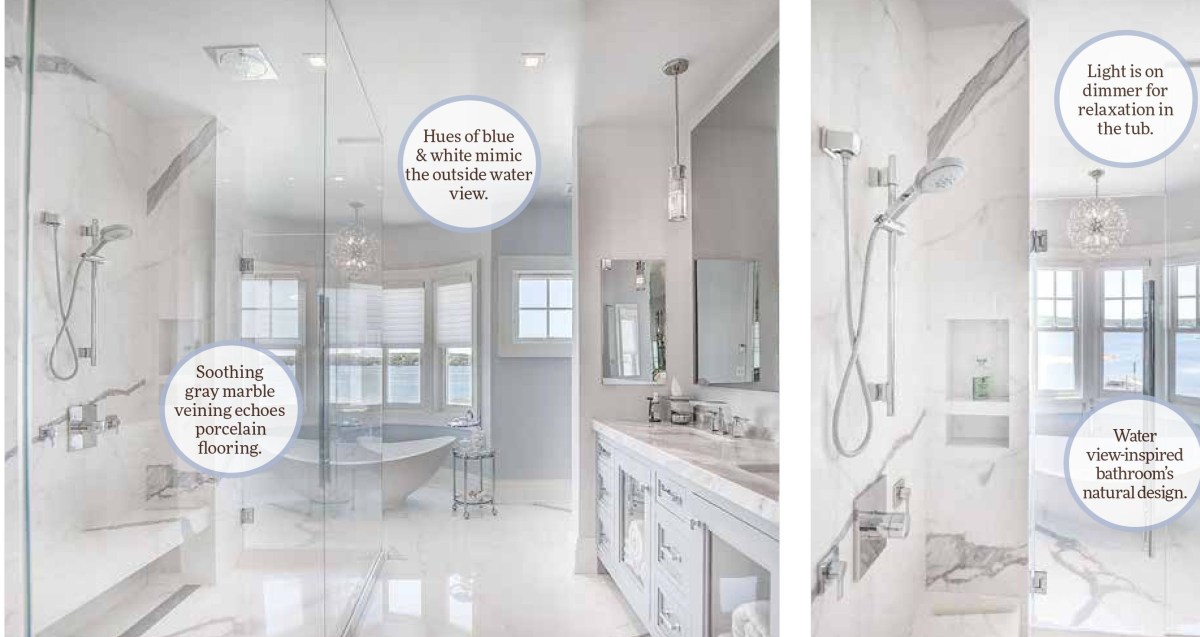In these tumultuous times, your home should be a peaceful respite from the chaotic world — an oasis for calm, relaxation and destressing.
When creating soothing spaces in a home, Christine Conte, owner of Christine Conte Interiors of Huntington, employs the concept of biophilia, a bond between human beings and nature that, when used in design, can reduce stress and improve well-being.
“The premise is to replicate characteristics of nature in our homes to trigger our minds to enter that restorative state that only nature provides,” explains Conte.
To achieve a relaxing space, start with the clean slate of an empty room, she advises.
NATURAL HUES
Consider color palates that are represented in nature, such as seashore blues and creams or forest greens and browns, advises Conte.
“For a relaxing space, consider using tints and shades of these colors in your paint selections,” says Conte. “Use flat finishes that absorb light and colors of the same intensity throughout the room to allow the mind to reset and rest.”
To achieve an overall sense of envelopment, paint the ceiling the same color as the walls, Conte says.
“For added luxury, consider using wallpaper in a natural material, such as grasscloth, wood, or cork,” she adds.
WARM LIGHTING
To enhance relaxation, choose adjustable levels of light, such as recessed lighting on dimmers, suggests Conte.
“Use warmer temperature light bulbs in lamps or consider investing in color light-therapy bulbs,” she says. “Blue light accelerates the relaxation process and green light brings on sleep faster.”
ORGANIC FABRICS & TEXTURES
Select fabrics and finishes in colors from your natural palate, advises Conte.
“Keep patterns to a minimum and stick to either textural solids or those with an organic motif,” she says.
For texture, opt for unfinished woods or ones that appear closest to their natural state, with live edges, knots, and bark.
“Furniture pieces using stone, cerused oak, rattan, and fossilized shell are very popular now and are an easy way to add natural texture to a room,” says Conte. “Natural fabrics like linen and wool that are textural and minimally processed are soft to the touch and wonderful to use in furniture selections, rugs, pillows and throws as a layer of natural comfort.”
KEEP IT COZY AND NATURAL
Warming up the room either through radiant heated floors or adding a fireplace feature can increase your room’s coziness factor, Conte says.
Art is the final element to set your natural stage.
“Consider large-scale photography of nature or natural pieces themselves, like grasses, shells, woven fabrics, and wood that have been turned into art,” Conte says.
RENOVATING VIA BIOPHILIA
For a recent bathroom renovation, Conte chose a soft blue and white color palette echoing the room’s water views.
Porcelain slabs with gray marble veining were used on the floor and shower walls, notes Conte, adding that a custom vanity and storage were crafted in the same color as the marble vein.
“The vanity is finished with a natural quartzite top that references water and crashing waves,” Conte says.
Coziness and warmth come from the tub, which is made from a material that always feels warm to the touch, a wall-mounted fireplace, radiant heated flooring, and a warming towel drawer.
“Recessed lighting and the tub chandelier are on dimmer switches for a relaxed setting when using the fireplace and tub,” she says.
Sign up for Long Island Press’ email newsletters here. Sign up for home delivery of Long Island Press here. Sign up for discounts by becoming a Long Island Press community partner here.


































